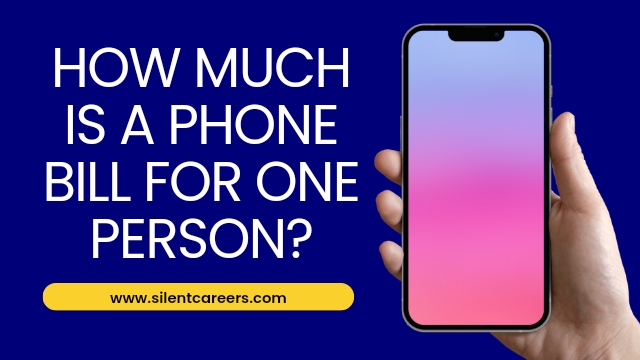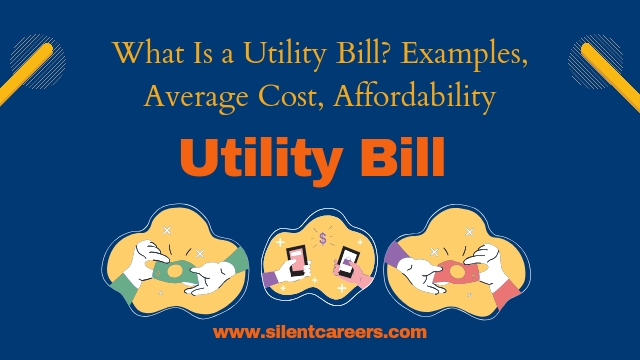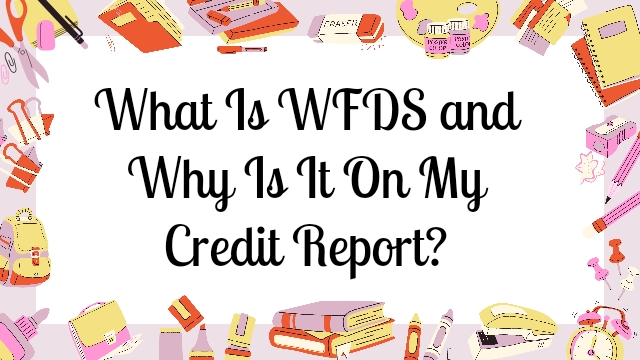
How Much Is a Phone Bill: A phone bill typically ranges from $30 to $100 per month, depending on the plan, carrier, data usage, and additional features like international calling or device payments.

How much should my cell phone bill cost?
The cost of a cell phone bill can vary widely depending on your needs and preferences. Here’s a general breakdown:
- Basic Plans: $20-$40 per month for limited talk, text, and data.
- Standard Plans: $50-$70 per month for unlimited talk, text, and moderate data usage.
- Premium Plans: $80-$100+ per month for unlimited talk, text, high data usage, and additional features like international calling and hotspot data.
Consider your usage patterns and budget to choose a plan that fits your needs.
The most inexpensive phone plans by carrier
Here are some of the most inexpensive phone plans offered by major carriers:
Verizon
- Start Unlimited: Starting at $70/month per line (with discounts for multiple lines)
- Prepaid Plan: Starts at $30/month for 5GB of data
AT&T
- AT&T Prepaid: Starts at $30/month for 5GB of data
- AT&T Value Plus: $50/month for unlimited talk, text, and data (single line only)
T-Mobile
- Essentials Plan: Starting at $60/month for a single line (less per line with more lines)
- T-Mobile Connect: Starts at $10/month for 1GB of data (prepaid plan)
Mint Mobile
- 3-Month Intro Plan: Starts at $15/month for 4GB of data (requires upfront payment for three months)
Visible (owned by Verizon)
- Visible Plan: $25/month for unlimited talk, text, and data (with Party Pay for multiple lines)
Boost Mobile
- Boost Mobile Prepaid: Starts at $15/month for 2GB of data
Cricket Wireless (owned by AT&T)
- Cricket Wireless Plan: Starts at $30/month for 2GB of data
Google Fi
- Flexible Plan: Starts at $20/month for unlimited talk and text, plus $10/GB for data
These plans vary in terms of data limits, speed, and additional features, so it’s important to compare them based on your specific needs and usage.
Cheapest cell phone service
Here are some of the cheapest cell phone service plans available, particularly from smaller or prepaid carriers:
Mint Mobile
- 3-Month Intro Plan: Starts at $15/month for 4GB of data, unlimited talk, and text. Requires upfront payment for three months.
Tello
- Value Plan: $10/month for 1GB of data, unlimited talk, and text. Customizable plans are available to fit specific needs.
Republic Wireless
- Base Plan: $15/month for unlimited talk and text. Data costs an additional $5 per GB.
Red Pocket Mobile
- Basic Plan: $10/month for 500 minutes, 500 texts, and 500MB of data. Uses major carrier networks for coverage.
TextNow
- Free Plan: Free with unlimited talk and text over Wi-Fi. Paid plans with data start at $8.99/month.
Boost Mobile
- Boost Mobile Prepaid: Starts at $15/month for 2GB of data, unlimited talk, and text.
Google Fi
- Flexible Plan: Starts at $20/month for unlimited talk and text, plus $10/GB for data. Ideal for low data users.
Ting
- Set 5 Plan: Starts at $10/month for 100 minutes, 100 texts, and 100MB of data. Customizable plans available.
These carriers and plans are known for their affordability, but it’s essential to ensure they provide good coverage and customer service in your area.
What impacts the cost of your phone bill?
The cost of your phone bill can be influenced by various factors, including:
- Plan Type:
- Unlimited Plans: Typically more expensive due to unlimited data, talk, and text.
- Limited Plans: Cheaper, with caps on data, talk, and text.
- Data Usage:
- Higher data allowances or unlimited data increase the cost.
- Overages on limited data plans can also add to the bill.
- Number of Lines:
- Family or multi-line plans often provide discounts per line compared to individual plans.
- Carrier:
- Major carriers (Verizon, AT&T, T-Mobile) often have higher prices than smaller or prepaid carriers.
- Features and Add-ons:
- Additional services like international calling, mobile hotspot, or device protection plans can add to the cost.
- Device Payments:
- Monthly payments for financed phones or tablets add to the bill.
- Early upgrade options or device insurance also contribute.
- Taxes and Fees:
- Government taxes, regulatory fees, and carrier-specific fees can significantly increase the final bill.
- Promotions and Discounts:
- Discounts for autopay, paperless billing, military, student, or senior plans can reduce costs.
- Promotions for new customers or bundled services (internet, TV) can also impact pricing.
- Roaming Charges:
- Using your phone outside your home country or network may incur additional fees.
- Contract vs. No-Contract:
- Contract plans may offer lower upfront costs for devices but can have higher monthly fees.
- No-contract or prepaid plans often have lower monthly costs but may require full payment for devices upfront.
Understanding these factors can help you choose a plan that fits your budget and usage needs.
How much is a typical phone bill?
A typical phone bill can vary widely based on several factors such as plan type, data usage, carrier, and additional features. Here’s a general breakdown:
Individual Plans:
- Basic/Limited Plans: $20-$40 per month (limited talk, text, and data)
- Standard Plans: $50-$70 per month (unlimited talk, text, and moderate data)
- Premium Plans: $80-$100+ per month (unlimited talk, text, high data usage, and additional features)
Family/Multi-Line Plans:
- Basic/Limited Plans: $60-$100 per month (for 2-4 lines, limited data)
- Standard Plans: $120-$160 per month (for 2-4 lines, unlimited talk, text, and moderate data)
- Premium Plans: $180-$240+ per month (for 2-4 lines, unlimited talk, text, high data usage, and additional features)
Prepaid Plans:
- Low Usage: $10-$30 per month (limited talk, text, and data)
- Moderate Usage: $30-$50 per month (moderate talk, text, and data)
- High Usage: $50-$70 per month (unlimited talk, text, and data)
Additional Costs:
- Device Payments: $20-$40 per month if you’re financing a new phone
- Taxes and Fees: Varies by region, typically adding 10-20% to the bill
- Add-Ons: Extra services like international calling, device insurance, and mobile hotspot can add $5-$20 per month each
Overall, the cost of a typical phone bill is often between $50 and $100 per month for individual plans, and $120 to $200+ per month for family plans, depending on the services and features included.
Read more: What is the minimum monthly payment on medical bills?
How can I reduce the cost of my phone bill?
Reducing the cost of your phone bill can be achieved through several strategies. Here are some tips:
- Evaluate Your Plan:
- Switch to a Lower-Tier Plan: If you don’t use a lot of data, switch to a plan with lower data limits.
- Consider Prepaid Plans: Prepaid plans often offer lower rates than postpaid plans.
- Optimize Data Usage:
- Use Wi-Fi: Connect to Wi-Fi whenever possible to reduce data usage.
- Monitor Usage: Track your data usage and avoid overages.
- Review Add-Ons:
- Remove Unnecessary Features: Cancel services like international calling, device protection, or other add-ons you don’t need.
- Use Free Apps: Use free messaging and calling apps like WhatsApp, Skype, or FaceTime.
- Take Advantage of Discounts:
- Employer or Association Discounts: Check if your employer or any associations you belong to offer discounts.
- Autopay and Paperless Billing: Enroll in autopay and paperless billing for possible discounts.
- Family or Group Plans:
- Share a Plan: Join a family or group plan to share costs and receive a lower per-line rate.
- Combine Services: Bundle your cell phone plan with other services like home internet or TV for discounts.
- Negotiate with Your Carrier:
- Call Customer Service: Contact your carrier to see if they can offer a better rate or match a competitor’s offer.
- Threaten to Switch: Sometimes, mentioning that you’re considering switching to a different carrier can prompt them to offer a discount.
- Avoid Device Financing:
- Buy Your Phone Outright: Purchasing your phone upfront can save on monthly payments and interest.
- Use an Unlocked Phone: Bring your own device to a carrier to avoid device financing costs.
- Review and Compare Plans Regularly:
- Shop Around: Periodically compare plans from different carriers to ensure you’re getting the best deal.
- Switch Carriers: If you find a better deal, consider switching to a different carrier.
Implementing these strategies can help you lower your phone bill and save money each month.
What can make your cell phone bill go up?
Several factors can cause your cell phone bill to increase. Here are some common reasons:
- Overage Charges:
- Data Overage: Exceeding your monthly data limit can result in additional charges.
- Talk and Text Overage: Exceeding your talk or text limits (if not on an unlimited plan) can also lead to extra fees.
- Roaming Charges:
- International Roaming: Using your phone while traveling abroad can incur significant charges if your plan doesn’t include international coverage.
- Domestic Roaming: Using your phone outside your carrier’s network within your country can also result in additional charges.
- Add-Ons and Features:
- Premium Features: Adding services like mobile hotspot, international calling, or streaming subscriptions can increase your bill.
- Device Protection: Opting for insurance or protection plans for your devices adds to the monthly cost.
- Device Payments:
- Financing a New Phone: Monthly payments for financed devices can add $20-$40 or more to your bill.
- Early Upgrade Programs: Participating in programs that allow frequent phone upgrades can result in higher monthly payments.
- Taxes and Fees:
- Government Taxes: Taxes imposed by federal, state, and local governments can increase your bill.
- Carrier Fees: Administrative, regulatory, and other fees charged by your carrier can add to the cost.
- Plan Changes:
- Upgrading Your Plan: Switching to a plan with more data or additional features usually costs more.
- Promotional Expiry: Introductory offers or discounts may expire, leading to higher regular rates.
- Usage-Based Charges:
- Pay-Per-Use Services: Using services not included in your plan, such as directory assistance or pay-per-use apps, can result in extra charges.
- Late Fees:
- Missed Payments: Failing to pay your bill on time can result in late fees being added to your next bill.
- International Calls and Texts:
- Out-of-Plan Communication: Making international calls or sending texts not covered by your plan can lead to additional charges.
Monitoring your usage, reviewing your bill regularly, and understanding your plan’s terms can help you avoid unexpected increases in your cell phone bill.
How to manage cell phone expenses
Managing cell phone expenses effectively requires a combination of careful monitoring, smart plan selection, and conscious usage habits. Here are some practical tips:
Choose the Right Plan
- Assess Your Needs:
- Determine your average data, talk, and text usage.
- Choose a plan that fits your typical usage to avoid overpaying for features you don’t need.
- Compare Plans:
- Shop around and compare plans from different carriers.
- Consider prepaid plans, which often offer lower rates.
Optimize Data Usage
- Use Wi-Fi:
- Connect to Wi-Fi whenever possible to reduce mobile data usage.
- Set your phone to automatically connect to known Wi-Fi networks.
- Monitor Usage:
- Use your phone’s settings or carrier’s app to track data usage.
- Set alerts for when you’re nearing your data limit.
Minimize Additional Costs
- Avoid Overage Charges:
- Choose an unlimited plan if you frequently exceed your data limits.
- Monitor talk and text usage if not on an unlimited plan.
- Review Add-Ons:
- Cancel unnecessary services like international calling or streaming subscriptions.
- Consider using free apps for messaging and calls.
Manage Device Costs
- Buy Outright or Finance Wisely:
- Buy your phone outright if possible to avoid monthly payments and interest.
- If financing, choose a plan with low or no interest.
- Use Unlocked Phones:
- Bring your own device to a carrier to avoid high device costs.
Take Advantage of Discounts
- Enroll in Discounts:
- Look for discounts for autopay, paperless billing, or bundling services.
- Check for employer, student, or senior discounts.
Regularly Review Your Bill
- Check for Errors:
- Review your bill each month for unexpected charges or errors.
- Contact customer service to dispute any incorrect charges.
- Evaluate Your Plan Periodically:
- Regularly assess if your current plan still meets your needs.
- Adjust your plan as needed to fit your usage and budget.
Negotiate with Your Carrier
- Negotiate Rates:
- Contact your carrier to ask for better rates or promotions.
- Mention competitors’ offers to leverage a better deal.
- Consider Switching Carriers:
- Be willing to switch carriers if you find a significantly better deal elsewhere.
Reduce Roaming and International Charges
- Use International Plans:
- If you travel frequently, consider a plan with international coverage.
- Use Wi-Fi for calls and messages while abroad to avoid roaming charges.
By implementing these strategies, you can effectively manage and reduce your cell phone expenses.
Cut your cell phone bill up to 50% with these 4 tips
You can cut your cell phone bill by up to 50% with these four tips:
- Switch to a Lower-Cost Plan: Evaluate your usage and switch to a plan with lower data, talk, and text limits that better matches your needs.
- Use Prepaid Services: Consider switching to a prepaid carrier, which often offers lower rates compared to traditional postpaid plans.
- Cancel Unnecessary Add-Ons: Remove extras like device protection or international calling if you don’t use them frequently.
- Negotiate with Your Carrier: Contact your carrier to negotiate a better rate or to inquire about discounts and promotions for loyal customers.
How much is an average iPhone bill per month?
The average monthly cost for an iPhone bill can vary depending on the plan and carrier. Here’s a general breakdown:
- Device Payments:
- Financed iPhone: $20-$40 per month for device payments (varies by model and carrier).
- Monthly Service Plans:
- Basic Plan: $30-$50 per month for limited talk, text, and data.
- Standard Plan: $50-$70 per month for unlimited talk, text, and moderate data.
- Premium Plan: $80-$100+ per month for unlimited talk, text, high data usage, and additional features.
- Total Average:
- Combining device payments with a standard service plan, the average monthly iPhone bill typically ranges from $70 to $120 per month.
Costs can vary based on the carrier, plan details, and whether you’re financing the device or paying upfront.
Why do cell phone bills fluctuate?
Cell phone bills can fluctuate due to several factors:
- Data Usage:
- Overages: If you exceed your data limit, you may incur extra charges or your data speeds may be throttled, leading to additional costs if you upgrade your plan mid-month.
- Data Plans: Changes in your data plan or promotions may also cause variations.
- Roaming and International Charges:
- Travel: Using your phone while traveling, either internationally or outside your carrier’s network, can result in unexpected charges.
- Roaming Fees: These can vary based on your location and the agreements between carriers.
- Add-Ons and Features:
- Additional Services: Charges for extras like international calling, mobile hotspot, or device protection can fluctuate based on usage or changes in services.
- Subscription Services: Adding or removing services like streaming or cloud storage affects your bill.
- Device Payments:
- Financing Changes: Adjustments in device payment plans or early termination of financing agreements can impact your monthly bill.
- Billing Cycles:
- Prorated Charges: If you change plans or add services mid-cycle, your bill might include prorated charges for the current billing period.
- Taxes and Fees:
- Variable Fees: Government taxes, regulatory fees, and carrier-specific charges can vary each month.
- Promotions and Discounts:
- Ending Promotions: Introductory discounts or promotional rates may expire, causing your bill to increase to the standard rate.
- Billing Errors:
- Incorrect Charges: Mistakes on your bill, such as accidental charges or errors, can cause fluctuations. Reviewing your bill regularly can help catch and resolve these issues.
Understanding these factors can help you manage and anticipate changes in your cell phone bill.
How much is too high for a phone bill?
Determining if your phone bill is too high depends on your budget, usage, and the value you’re receiving. Here are some general guidelines to help you assess:
- Percentage of Income:
- Recommended Range: Aim for your phone bill to be less than 5% of your monthly income. If your bill exceeds this percentage, it might be worth reassessing your plan.
- Comparison with Average Costs:
- Individual Plans: Average monthly costs for phone bills generally range from $50 to $100 for most individuals.
- Family Plans: Family plans often cost between $120 and $200+ per month.
- Value vs. Usage:
- Overpayment for Features: If you’re paying for features or data you don’t use, it might indicate that your bill is too high relative to your needs.
- Unused Data: If you consistently use less data or fewer services than your plan offers, you might be overpaying.
- Comparison with Alternatives:
- Competitive Rates: Compare your bill with similar plans from other carriers. If you find significantly cheaper options for similar services, your current bill might be too high.
- Budget Considerations:
- Financial Impact: If your phone bill strains your budget or causes financial discomfort, it’s a sign that it may be too high.
If your phone bill consistently exceeds these benchmarks or causes budgetary issues, it may be time to explore more cost-effective plans or options.








